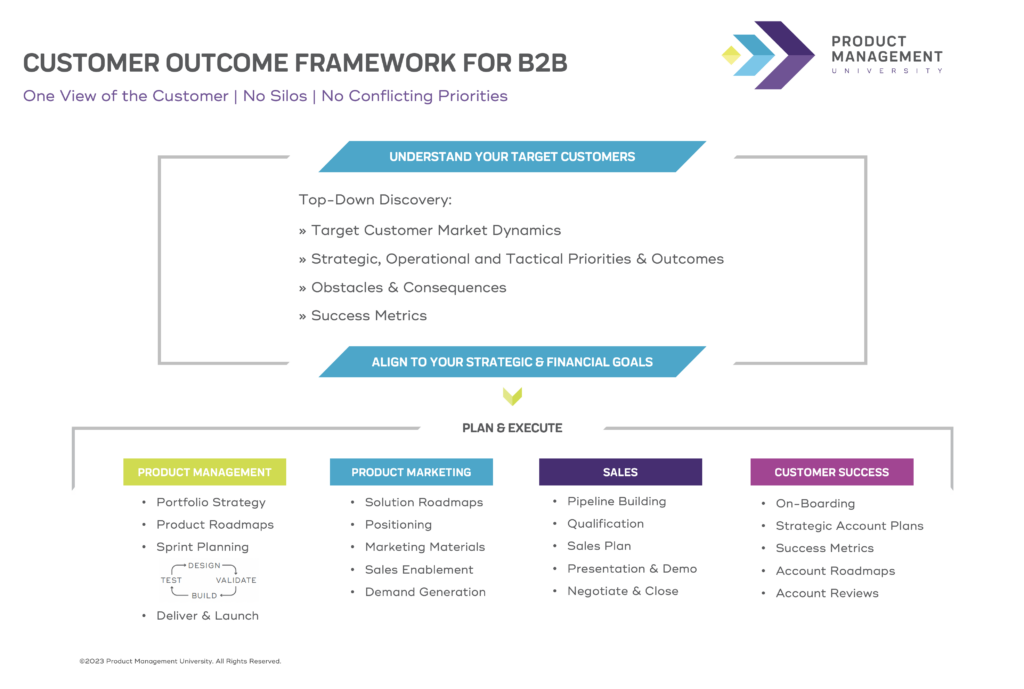Bridging the Gap – Strategic vs Tactical Customer Discovery

Market and customer discovery is the single most foundational skill for success in product management and product marketing. There are two things to consider when it comes to being more strategic in your discovery. One of them is obvious and the other is rarely if ever discussed.
Let’s start with the obvious one, understanding what’s driving your target customers strategically from the top down. This is the lynchpin to finding the departments, users and jobs that have the biggest impact on those strategic goals.
As a product management organization, your products should ideally make users measurably better at their job in ways that have strategic value to their organization. If you’re not approaching discovery from the top down, delivering products with strategic value to the customer and to your own organization will be an uphill battle for the duration.
The second aspect of discovery that makes your team more strategic, and it’s rarely mentioned, is elevating its leadership stature internally with greater market and customer knowledge than all other disciplines.
Since everything starts with the products, that means product management as a whole, should be more knowledgeable than all other disciplines on the market and the business of your target customers. Traditional product/customer discovery won’t even get you in the ballpark.
There are five deficiencies with traditional product/customer discovery that are inhibiting your ability to be more strategic. The bottom line is that traditional customer discovery is too tactical and carries a heavy dose of product bias with it!
If the heat is on your team to be more strategic and drive greater growth, bridging the gap on these five customer discovery deficiencies will get you off to a strong start.

1. Starting Discovery With Users vs. Ending With Users
The most important thing to remember about customer discovery in B2B is that it ends with users. It doesn’t start with them. It’s imperative you understand what’s driving your target customers from the top down so that it leads you to the departments, users and jobs with the biggest impact.
User and product discovery becomes more important as you get closer to the product/solution definition and product design.
2. Discovery With Product Bias
The more you know about your products, the harder it is to identify unmet customer needs with strategic value. Doing customer discovery as if your products didn’t exist is one of the most difficult things for product managers and product marketing managers, and it’s also a big reason so many products consistently miss the mark for strategic value.
3. Starting With Customer Problems
“Tell me what your biggest problems are” is a typical starting point for a discovery conversation. Here’s the thing. Not all customer problems are tied to business outcomes that matter. It’s too easy to solve legitimate user problems that have little or no value to the business when your discovery process is too centered on finding problems.
Here’s the most important thing to remember if you’re looking to be more strategic. Your economic buyers have compensation tied to results, a.k.a. outcomes that can be quantified. Start there and find out what’s stopping them and you’ll have value targets that are both strategic and quantifiable!
4. Too Many Questions
The whole point of customer discovery is to have a conversation about their business priorities and why they’re important. The end result is to come away with needs that have measurable strategic value to their business. How many pages of questions do you have in your customer discovery guide?
There are five simple questions to drive any discovery conversation with any customer at any level. The context of these questions will change depending on who you’re conversing with.
5. Teams Are Structured for Tactical User Discovery Only
Most product management & product marketing teams aren’t structured to do discovery from the top of the customer organization down in a way that’s scalable. It’s not feasible to expect every product manager or product marketing manager to do top-down discovery and it doesn’t even make sense to approach it that way.
Strategic Customer Discovery & Your Portfolio Strategy
If you’re going to uncover needs that have strategic value to your target customers, discovery has to first be done at the broader organization level without any regard to your products in order to understand what’s driving them from the top down.
Now you can craft a portfolio strategy where every product has a role in helping customers get the outcomes that are strategic to their business. Product and user discovery to follow as you begin the solutioning process with clear strategic value targets front and center!
Becoming More Strategic
Click here if you want to experience the easiest way to learn product management, product marketing, pre-sales demos and customer success with our unique hands-on learning format. Be sure to check out our Product Management Framework that simplifies everything by making customer outcomes the starting point for building, marketing, selling and delivering strategic value.
Subscribe to The Product Vibe or follow Product Management University on LinkedIn to make sure you get the 10-part post.
by John Mansour on October 4, 2023.